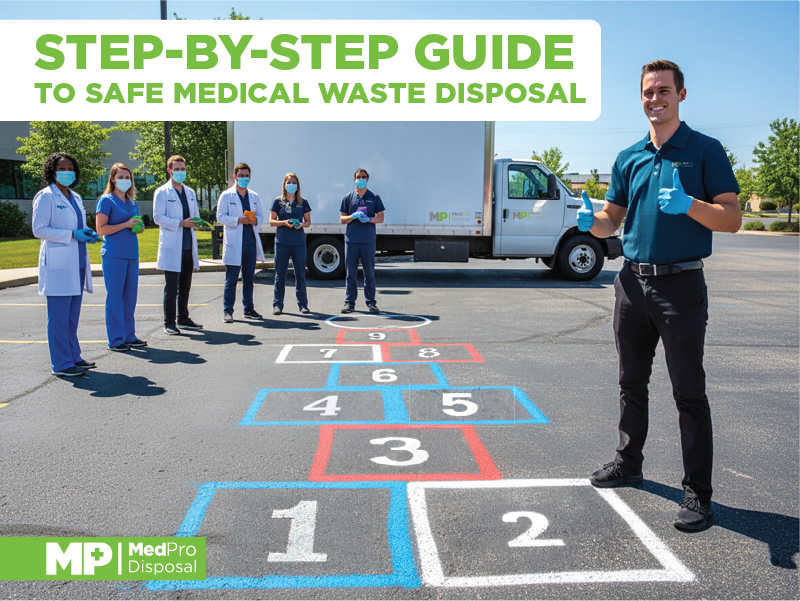Having a guide on how to dispose of medical waste in busy healthcare facilities is both practical and useful. Healthcare staff already juggle patient care with strict compliance demands.
Having a handy guide helps them do two things at the same time. They can provide care while keeping their facilities compliant and safe. Waste management often takes a back seat in busy healthcare facilities. The problem is, improper disposal causes harm — infections, injuries, fines, and reputational harm.
This step-by-step guide takes the complexity out of the process. It introduces a reliable and safe medical waste disposal process. This guide will also walk you through how to dispose of medical waste properly and compliantly.
How to Dispose of Medical Waste in Busy Healthcare Facilities
The process of how to dispose medical waste in busy healthcare facilities can seem complicated. But it’s not.
The medical waste disposal process has a clear flow. First, waste is generated. Then, it is separated into types. After that, it is secured. Next, it is transported. Then, it is treated. Finally, it is disposed of.
This flow ensures safety for your staff, patients, and the local community. It follows a medical waste disposal process that protects your facility from violations and expensive compliance penalties.
Steps for Disposing of Medical Waste in Busy Healthcare Settings
- Generation: Medical waste is created during care, ranging from sharps to contaminated dressings.
- Segregation: Separate at the source using puncture-resistant sharps containers and color-coded biohazard bags.
- Packaging and Labeling: Secure, label, and seal containers following OSHA and EPA rules.
- Storage: Place sealed containers in a secure, ventilated area until pickup.
- Transport: Use licensed haulers who meet DOT standards for medical waste transport.
- Treatment: Have your waste sanitized and destroyed at licensed facilities.
- Final Disposal: Once treated, it may go to landfills or waste-to-energy plants.
Working with a provider like MedPro ensures that the steps for disposing of medical waste are completed properly.
Which Regulations Guide Safe Medical Waste Disposal?
Several agencies have important roles. They create regulations for the safe disposal of medical waste.
- Occupational Safety and Health Administration (OSHA): This agency focuses on worker protection. They provide safety guidelines through training, labeling, and sharps handling requirements.
- Environmental Protection Agency (EPA): Oversees environmental standards, emissions, and landfill safety.
- Department of Transportation (DOT): Oversees waste transport. DOT regulates the packaging and transport of medical waste across state lines.
- CDC and state health departments: Issue infection control guidelines and state-specific rules.
Compliance with all these agencies prevents fines, injuries, and legal liability. They ensure that the steps for disposing of medical waste — from your facility to disposal — are followed.
How to Dispose of Medical Waste Properly in Busy Clinics and Hospitals
Each healthcare setting has unique waste challenges. Each facility has its own medical waste disposal process, suitable to its needs and waste volume.
- Hospitals: Handle high volumes of sharps, infectious waste, and pharmaceuticals. They require strict schedules and comprehensive disposal solutions.
- Clinics and outpatient centers: Generate smaller but steady volumes. Flexible pickups prevent overfilling and compliance lapses.
- Nursing homes: Manage sharps and infectious waste daily, often with limited staff. Simplified disposal solutions help them stay compliant.
- Pharmacies and labs: Deal with expired drugs and chemical waste, requiring specialized handling.
MedPro Disposal trains your staff for safe disposal of medical waste. We tailor waste pickups and help you simplify compliance across all these verticals.

Medical Waste Disposal Checklist for Healthcare Staff
Below is a checklist you can use for the safe disposal of medical waste and to manage your compliance.
Before Disposal
- Identify waste type: sharps, infectious, pharmaceutical, pathological, or general.
- Use the correct color-coded container.
- Confirm the container is intact, labeled, and not overfilled.
- Wear PPE (with gloves and masks for added protection against splash risks).
During Disposal
- Dispose of waste immediately at the point of generation.
- Place sharps directly into containers without recapping.
- Seal sharps containers when they’re two-thirds of the way full.
- Tie bags securely when they’re two-thirds of the way full.
After Disposal
- Store sealed containers in designated secure areas.
- Report damaged or full containers immediately.
- Follow facility transport protocols.
- Complete regular staff training.
This checklist maximizes the safe disposal of medical waste. It minimizes risks and reinforces compliance across your facility (or facilities).
Step-by-Step Guide on How to Dispose of Medical Waste Properly
Healthcare staff need clear guidance, not guesswork. The following steps highlight best practices for segregation, containment, and compliance.
On-Site Segregation and Use of Sharps Containers and Biohazard Bins
Sharps and contaminated waste require immediate disposal at the point of use. Place needles, scalpels, and syringes directly into puncture-proof sharps containers. Use red biohazard bags for gloves and gauze. Collection tubes that contain blood or infectious materials enter the bags, too.
OSHA requires clear labeling with the biohazard symbol. Staff training at this stage prevents cross-contamination and needle-stick injuries.
Packaging, Labeling, and Storage Guidelines
Containers must be durable, leak-proof, and never overfilled. Seal sharps containers when two-thirds full and tie bags securely.
Label all containers with hazard warnings, and in some states, with facility identification. Store sealed waste in a secure, ventilated area until pickup. Do not store waste beyond the maximum timeframe set by state or local health departments.
Transporting Medical Waste Securely and Compliantly
Once ready, your medical waste must be transferred by a DOT-licensed hauler. Trucks must secure containers against spills, leaks, or tampering. Using a reliable vendor ensures your facility meets chain-of-custody requirements and avoids liability.
Where Does Medical Waste Go After It Leaves a Healthcare Facility?
Once waste leaves your facility, it goes through treatment and final disposal. Common medical waste treatment methods include:
- Autoclaving: Destroys pathogens, allowing safer landfill disposal.
- Incineration: Used for pathological and pharmaceutical waste.
- Chemical and microwave treatment: Neutralizes infectious waste before disposal.
Note that these medical waste treatment methods are not available to everyone. Most smaller healthcare facilities do not have the resources on-site to apply these medical waste treatment methods.
This is where waste disposal services providers like MedPro Disposal come in. They can collect your medical waste and transport it to the appropriate treatment facility.
After treatment, where does medical waste go after disposal? Two options: First, your medical waste is buried in safe landfill sites. Alternatively, it can go to waste-to-energy facilities where it contributes to power generation. Treatment facilities operate under EPA, WHO, and state oversight to safeguard the environment.
Why Work with a Medical Waste Disposal Company Like MedPro Disposal?
MedPro Disposal serves over 40,000 clients across 48 states. We make compliance simple for busy healthcare and medical facilities. By choosing MedPro, you gain:
- Nationwide coverage with local flexibility — personalized service for each client. We tailor waste disposal pickups that fit your schedule and waste volume.
- Dedicated customer service teams — one point of contact for consistent support.
- Low, predictable costs — budget-friendly plans with no hidden fees.
- Comprehensive liability protection — $33 million insurance coverage.
- Educational partnership — training, audits, and step-by-step guidance for staff.
With MedPro, you reduce costs, streamline operations, and stay audit-ready.
Safe, Compliant Medical Waste Disposal Made Simple
Healthcare facilities cannot afford to risk unsafe disposal, staff injuries, or regulatory fines. This guide gives your staff the tools to manage waste confidently. They can protect patients and maintain full compliance.
MedPro Disposal simplifies the process with nationwide coverage, reliable pickups, and personalized support. Reach out to MedPro today. We’ll help design a guide on how to dispose of medical waste. A plan that works with your busy schedule and meets compliance standards.
Call Us Now for Your FREE Quick Quote 👉 888-641-6131.







